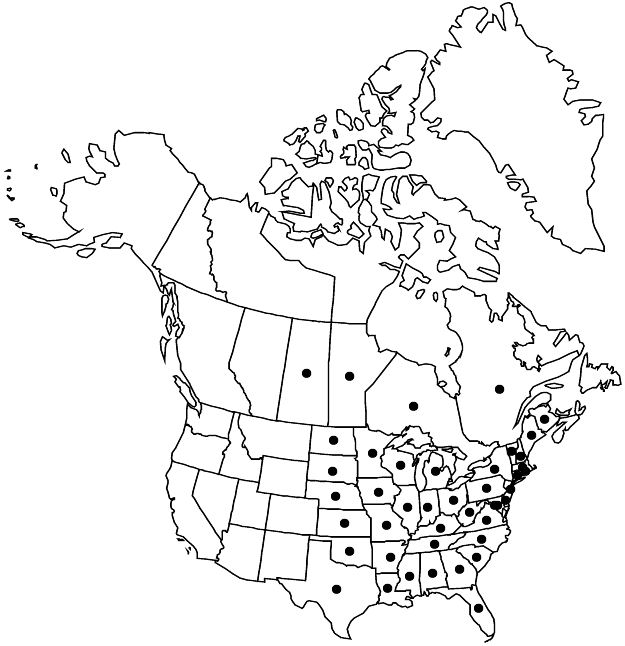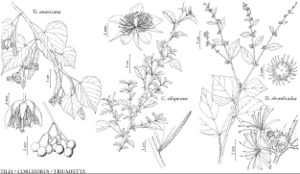Difference between revisions of "Tilia americana"
Sp. Pl. 1: 514. 1753.
imported>Volume Importer |
imported>Volume Importer |
||
| Line 140: | Line 140: | ||
|publication year=1753 | |publication year=1753 | ||
|special status=Illustrated | |special status=Illustrated | ||
| − | |source xml=https:// | + | |source xml=https://bitbucket.org/aafc-mbb/fna-data-curation/src/2e0870ddd59836b60bcf96646a41e87ea5a5943a/coarse_grained_fna_xml/V6/V6_349.xml |
|subfamily=Malvaceae subfam. Tilioideae | |subfamily=Malvaceae subfam. Tilioideae | ||
|genus=Tilia | |genus=Tilia | ||
Latest revision as of 22:20, 5 November 2020
Trees sometimes multitrunked. Leaf blades (on flowering shoots) 5–15(–20) × 5–12+ cm, abaxial surfaces initially glabrate but for tufts of simple, forked, or fascicled hairs at some vein axils, or initially densely to sparsely stellate-hairy, then sometimes glabrescent, with or without tufts of simple, forked, or fascicled hairs at some vein axils, adaxial surfaces usually glabrous or glabrate. Inflorescences: bracts 7–15 cm, notably reticulate-veined, notably hairy, glabrescent, or glabrate; peduncle diverging from near or beyond midlength of bract. Pedicels weakly clavate, 4–15+ mm, notably hairy, glabrescent, or glabrate. Flowers: sepals 4–6(–9+) mm; petals 5–9(–11) mm; staminodes 4–7(–10) mm. Fruits ellipsoid to globose, 5–10 mm diam. 2n = 82.
Phenology: Flowering (Apr–)Jun–Jul.
Habitat: Forests, stream and lake shores
Elevation: 10–800 m
Distribution

Man., N.B., Ont., Que., Sask., Ala., Ark., Conn., Del., D.C., Fla., Ga., Ill., Ind., Iowa, Kans., Ky., La., Maine, Md., Mass., Mich., Minn., Miss., Mo., Nebr., N.H., N.J., N.Y., N.C., N.Dak., Ohio, Okla., Pa., R.I., S.C., S.Dak., Tenn., Tex., Vt., Va., W.Va., Wis., Mexico.
Discussion
In preparing this treatment, I tried to see merit in taxonomies in which more than one Tilia species native to the flora area are recognized. In the end, my experiences with specimens and my attempts at using taxonomies that purport to delineate distinct species and/or infraspecific taxa of Tilia in the flora area led me to agree with W. C. Ashby (1964), J. W. Hardin (1990), L. G. Hickok and J. C. Anway (1972), and H. Kurz and R. K. Godfrey (1962) that taxonomic recognition of more than one native Tilia species in the flora area is not tenable. I also concluded that recognition of infraspecific taxa within that one species in the flora area is not tenable.
If Tilia americana is partitioned (for example, by J. W. Hardin 1990), infraspecific taxa in the flora area may be characterized like so:
Variety americana has abaxial surfaces of leaves of flowering shoots initially glabrate but for tufts of simple, forked, and/or fascicled hairs at some vein axils.
Variety caroliniana has abaxial surfaces of leaves of flowering shoots initially sparsely to moderately stellate-hairy and with simple, forked, and/or fascicled hairs scattered and/or in tufts at some vein axils; attachments of the stellate hairs are usually fragile and the stellate hairs become sparser as seasons progress.
Variety heterophylla has abaxial surfaces of leaves of flowering shoots initially moderately to densely stellate-hairy and with simple, forked, and/or fascicled hairs scattered and/or in tufts at some vein axils; attachments of the stellate hairs are usually firm and the stellate hairs usually persist as seasons progress.
J. W. Hardin (1990) included Tilia mexicana Schlechtendal, native to Mexico (at least 14 states), in the circumscription of T. americana adopted here and treated it as T. americana var. mexicana (Schlechtendal) Hardin.
D. Pigott (2012) treated native tilias of North America as: Tilia americana var. americana, T. americana var. neglecta, T. caroliniana subsp. caroliniana, T. caroliniana subsp. floridana (extending into Mexico), T. caroliniana subsp. heterophylla, T. caroliniana subsp. occidentalis (Mexico), and T. ×stellata.
Selected References
None.
